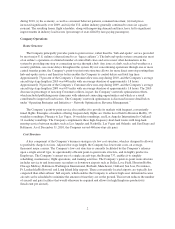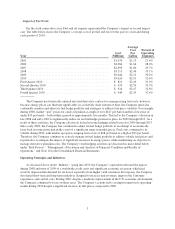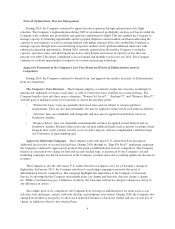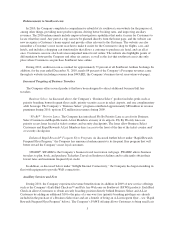Southwest Airlines 2010 Annual Report Download - page 18
Download and view the complete annual report
Please find page 18 of the 2010 Southwest Airlines annual report below. You can navigate through the pages in the report by either clicking on the pages listed below, or by using the keyword search tool below to find specific information within the annual report.security measures regulating the types of liquid items that can be carried onboard aircraft. In 2009, the TSA
introduced its Secure Flight program. Secure Flight requires airlines to collect a passenger’s full name (as it
appears on a government-issued ID), date of birth, gender, and Redress Number (if applicable). Airlines must
transmit this information to Secure Flight, which uses the information to perform matching against terrorist
watch lists. After matching passenger information against the watch lists, Secure Flight transmits the matching
results back to airlines. This serves to identify individuals for enhanced security screening and to prevent
individuals on watch lists from boarding an aircraft. It also helps prevent the misidentification of passengers who
have names similar to individuals on watch lists. In 2010, the TSA also implemented enhanced security
procedures as part of its enhanced, multi-layer approach to airport security by employing advanced imaging
technology (full body scans), as well as new physical pat down procedures, at security checkpoints. Such
enhanced security procedures have raised privacy concerns by some air travelers.
Enhanced security measures have also impacted the Company’s business through the imposition of security
fees on the Company’s Customers and on the Company. Under ATSA, funding for passenger security is provided
in part by a $2.50 per enplanement security fee (the “9/11 Fee”), subject to a maximum of $5.00 per one-way
trip. Congress may consider an increase in the 9/11 Fee, as well as other changes to ATSA, as part of future
security-related legislation. ATSA also allows the TSA to assess an Aviation Security Infrastructure Fee
(“ASIF”) on each airline. The Company’s ASIF liability was originally set at $26 million per year. Effective for
calendar year 2005, the TSA unilaterally increased the amount by an additional $24 million to a total of $50
million annually. The Company and 22 other airlines joined in litigation against the TSA to challenge the
agency’s increase to their respective ASIF fees. In February 2009, the U.S. Court of Appeals for the District of
Columbia Circuit ruled that the increased fees were excessive and remanded the matter to the TSA to determine
the amount of the excess. In June 2010, the TSA made a partial refund of $18 million to the Company and
reduced its fees going forward by $3.5 million annually. The Company and other airlines have petitioned the
Court of Appeals to invalidate the TSA’s action and require it to make larger refunds and reductions.
The Company has made significant investments to address the effect of security regulations, including
investments in facilities, equipment, and technology to process Customers efficiently and restore the airport
experience; however, the Company is not able to predict the ongoing impact, if any, that various security
measures will have on Passenger revenues and the Company’s costs, both in the short-term and the long-term.
Environmental Regulation
The Company is subject to various federal laws and regulations relating to the protection of the
environment, including the Clean Air Act, the Resource Conservation and Recovery Act, the Clean Water Act,
the Safe Drinking Water Act, and the Comprehensive Environmental Response, Compensation and Liability Act,
as well as state and local laws and regulations. These laws and regulations govern aircraft drinking water and the
discharge or disposal of materials such as chemicals, hazardous waste, and aircraft deicing fluid. Additionally, in
conjunction with airport authorities, other airlines, and state and local environmental regulatory agencies, the
Company, as a normal course of business, undertakes voluntary investigation or remediation of soil or
groundwater contamination at several airport sites. The Company does not believe that any environmental
liability associated with these airport sites will have a material adverse effect on the Company’s operations, costs,
or profitability, nor has it experienced any such liability in the past that has had a material adverse effect on its
operations, costs, or profitability. Further regulatory developments pertaining to the control of engine exhaust
emissions from ground support equipment could increase operating costs in the airline industry. The Company
does not believe, however, that pending environmental regulatory developments in this area will have a material
effect on the Company’s capital expenditures or otherwise materially adversely affect its operations, operating
costs, or competitive position.
The federal government, as well as several state and local governments, are considering legislative and
regulatory proposals to address climate change by reducing green house gas emissions. At the federal level, the
Environmental Protection Agency’s Endangerment Finding in January 2010 regarding greenhouse gas emissions
set the stage for possible legislative or regulatory action to reduce greenhouse gas emissions from various
12
























